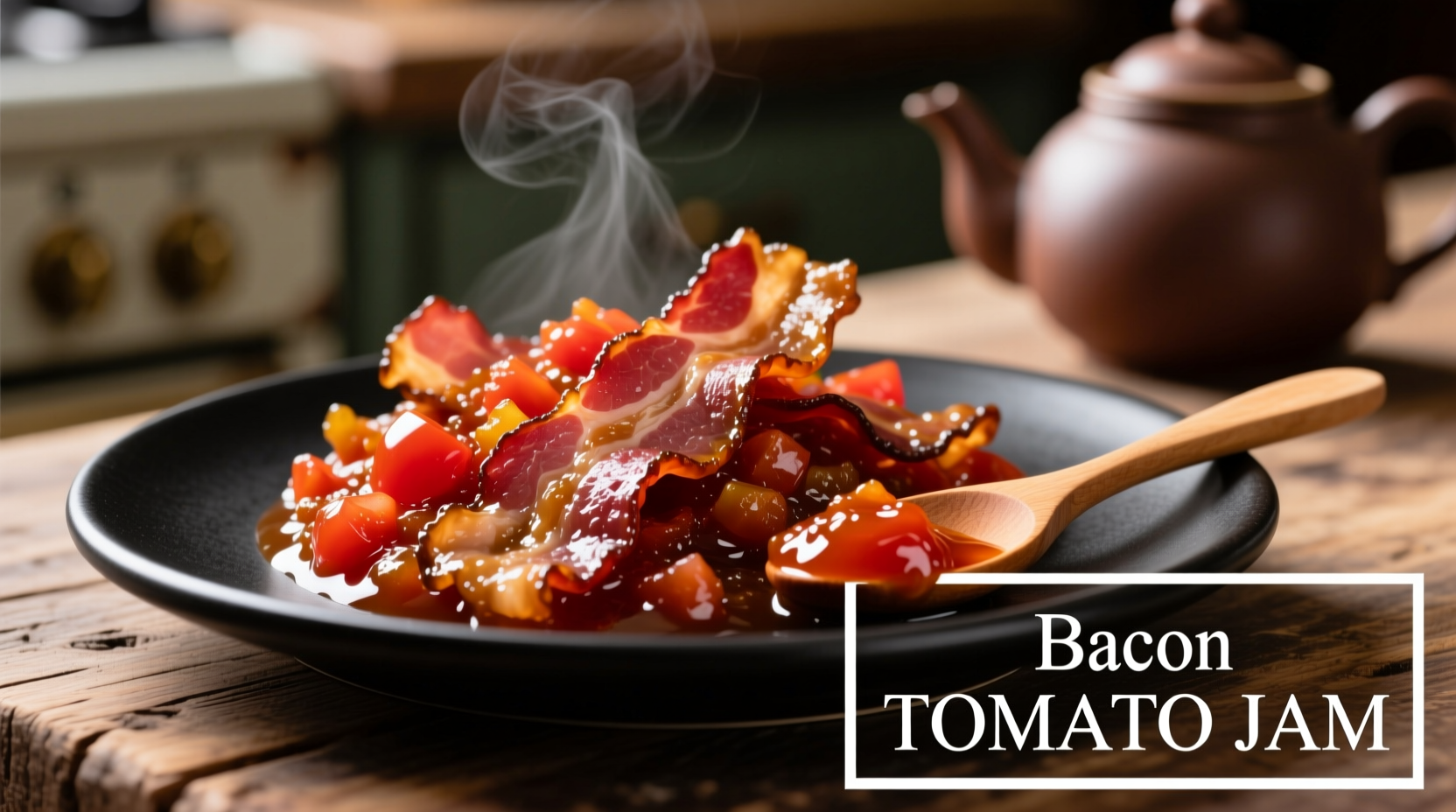Curious about bacon in your jam? You're not alone. This unexpected combination has gained popularity among home cooks and professional chefs seeking complex flavor profiles. Unlike traditional fruit jams, bacon tomato jam creates a sophisticated balance where the smoky richness of bacon enhances tomatoes' natural sweetness, while vinegar provides necessary acidity for both flavor and safe preservation.
The Flavor Science Behind This Unlikely Pairing
Food chemistry explains why bacon and tomatoes work so well together. Tomatoes contain glutamic acid, which creates umami—the fifth taste sensation. When combined with bacon's naturally occurring inosinate compounds, the umami effect multiplies through synergistic amplification, creating deeper savory notes than either ingredient alone. This scientific principle, documented by the USDA Food Safety and Inspection Service, explains why these ingredients complement each other perfectly in preserves.
| Flavor Component | Source Ingredient | Contribution to Final Product |
|---|---|---|
| Umami | Bacon (inosinate) + Tomatoes (glutamate) | Creates rich savory depth through synergy |
| Sweetness | Ripe tomatoes + added sugar | Counters saltiness while enhancing fruit notes |
| Acidity | Vinegar + tomato natural acids | Preserves texture and balances richness |
| Smoke | Cured bacon | Adds complexity without overpowering |
When Bacon Tomato Jam Works Best (And When It Doesn't)
This preserve shines in specific culinary contexts but falls short in others. Understanding these boundaries ensures perfect application:
- Ideal pairings: Strong-flavored cheeses like aged cheddar or blue cheese, roasted poultry, grilled pork, and hearty artisan breads
- Avoid with: Delicate fish, light salads, or anything where subtle flavors would be overwhelmed
- Texture considerations: Best when bacon is finely diced (¼-inch pieces) to distribute evenly without creating chewy bits
- Seasonal timing: Peak tomato season (July-September) yields the most vibrant flavor with minimal added sugar
Creating Perfect Bacon Tomato Jam: A Step-by-Step Guide
Professional chefs recommend this tested method for optimal results. The key is balancing smoke, sweetness, and acidity while ensuring food safety:
- Cook 8 ounces of thick-cut bacon until crisp, then drain and finely dice
- Combine 2 pounds ripe tomatoes (peeled and chopped), 1 cup sugar, ½ cup apple cider vinegar, and the bacon in a heavy pot
- Simmer uncovered for 45-60 minutes, stirring occasionally, until thickened
- Test for proper set by placing a spoonful on a chilled plate—if it wrinkles when pushed, it's ready
- Process in a boiling water bath for 10 minutes for shelf-stable preservation
Following National Center for Home Food Preservation guidelines, maintain a pH below 4.6 to prevent botulism risk. The vinegar content in this recipe ensures safe acidity levels for home canning.

Evolution of Savory Preserves: A Culinary Timeline
Savory fruit preserves have historical roots that explain today's bacon tomato jam trend:
- 1700s: European kitchens preserved fruits with spices and meats for winter provisions
- 1800s: Victorian cookbooks featured recipes like "bacon and apple preserve" for charcuterie boards
- 1930s: Depression-era cooking combined scarce meats with abundant garden produce
- 2000s: Modern gastropub movement revived interest in complex savory preserves
- Present: Food science understanding has refined techniques for optimal flavor balance
Troubleshooting Common Issues
Even experienced preserve makers encounter challenges. Here's how to fix them:
- Too salty: Add a peeled, cored apple during cooking to absorb excess salt
- Runny texture: Return to heat and cook 10-15 minutes longer, or add 1 tablespoon chia seeds
- Bacon too chewy: Dice smaller (⅛-inch) and cook longer to render fat completely
- Overpowering smoke: Use naturally smoked rather than liquid smoke bacon varieties
Storage and Shelf Life Guidelines
Proper storage ensures both safety and quality. According to FDA food preservation standards, properly processed bacon tomato jam maintains quality for 18 months unopened. Once opened, refrigerate and use within 3 weeks. Always check for signs of spoilage—including mold, off odors, or bulging lids—before consumption.
Three Unexpected Serving Ideas
Move beyond basic toast with these chef-recommended applications:
- Breakfast transformation: Spread on English muffins with fried eggs and arugula for a gourmet breakfast sandwich
- Cocktail party shortcut: Top baked brie with warmed jam and toasted pecans for an impressive appetizer
- Weeknight dinner upgrade: Glaze roasted chicken thighs during the last 10 minutes of cooking for caramelized perfection











 浙公网安备
33010002000092号
浙公网安备
33010002000092号 浙B2-20120091-4
浙B2-20120091-4